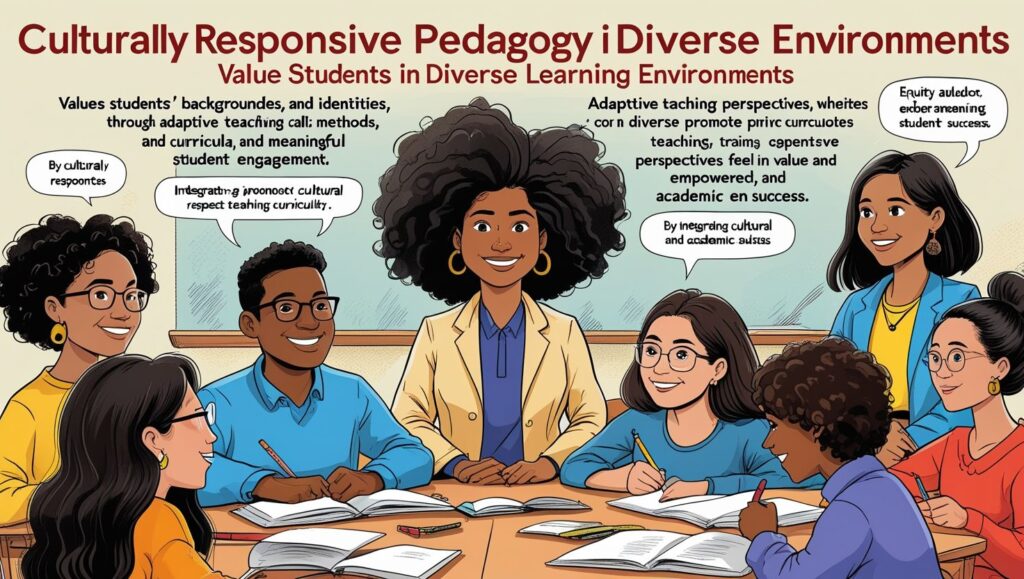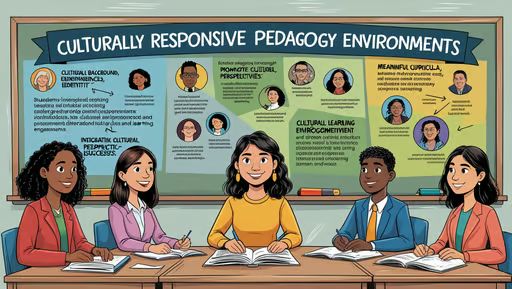Culturally Responsive Pedagogy in Diverse Learning Environments, In today’s increasingly globalized and multicultural world, classrooms are more diverse than ever. Students come from a wide range of cultural, linguistic, and socioeconomic backgrounds, each bringing unique perspectives and experiences to the learning environment. Culturally responsive pedagogy (CRP) is an educational approach that recognizes and values this diversity, aiming to create inclusive and equitable learning experiences for all students. By integrating students’ cultural identities into teaching practices, educators can foster engagement, improve academic outcomes, and promote social justice. This article explores the principles of culturally responsive pedagogy, its benefits, practical strategies for implementation, and challenges educators may face.
Understanding Culturally Responsive Pedagogy
Culturally responsive pedagogy is rooted in the belief that culture plays a central role in learning. It emphasizes the importance of understanding and respecting students’ cultural backgrounds, experiences, and perspectives. CRP goes beyond superficial representations of diversity, such as celebrating cultural holidays, to deeply embedding cultural relevance into curriculum design, teaching methods, and classroom interactions. This approach requires educators to reflect on their own cultural biases and assumptions, and to actively work toward creating a classroom environment where all students feel valued and empowered.
At its core, culturally responsive pedagogy is about building relationships and fostering a sense of belonging. It recognizes that students learn best when they see themselves reflected in the curriculum and when their experiences are validated. By connecting learning to students’ lives, CRP helps bridge the gap between school and home, making education more meaningful and engaging.
The Benefits of Culturally Responsive Pedagogy
Culturally responsive pedagogy offers numerous benefits for students, teachers, and the broader school community. For students, CRP can lead to increased engagement, motivation, and academic achievement. When students see their cultures and identities represented in the classroom, they are more likely to feel connected to the material and invested in their learning. CRP also promotes critical thinking and problem-solving skills by encouraging students to analyze issues from multiple perspectives.
For teachers, culturally responsive pedagogy provides an opportunity to deepen their understanding of their students and to develop more effective teaching practices. By embracing diversity, educators can create a more dynamic and inclusive classroom environment. Additionally, CRP aligns with social justice principles, helping to address systemic inequities in education and empowering marginalized students.
At the school level, culturally responsive pedagogy can contribute to a more positive and inclusive school culture. It encourages collaboration among staff, students, and families, fostering a sense of community and shared responsibility for student success.
Practical Strategies for Implementing CRP
Implementing culturally responsive pedagogy requires intentionality and commitment. Here are some practical strategies educators can use to integrate CRP into their classrooms:
- Get to Know Your Students: Take the time to learn about your students’ cultural backgrounds, interests, and experiences. This can be done through surveys, one-on-one conversations, or family engagement activities. Understanding your students’ identities is the foundation of culturally responsive teaching.
- Incorporate Diverse Perspectives: Ensure that the curriculum reflects the diversity of your students and the world. Include texts, examples, and case studies from a variety of cultures and viewpoints. This helps students see themselves in the material and broadens their understanding of different cultures.
- Use Culturally Relevant Teaching Methods: Adapt your teaching methods to align with your students’ cultural learning styles. For example, some cultures value collaborative learning, while others emphasize storytelling or hands-on activities. Incorporating these approaches can make learning more accessible and engaging.
- Create an Inclusive Classroom Environment: Foster a classroom culture that values diversity and promotes respect. Display multicultural materials, celebrate cultural achievements, and establish norms that encourage open dialogue and mutual understanding.
- Encourage Student Voice and Choice: Give students opportunities to share their perspectives and take ownership of their learning. This can be done through projects, presentations, or discussions that allow students to explore topics relevant to their lives and cultures.
- Address Bias and Stereotypes: Be mindful of implicit biases and stereotypes that may influence your interactions with students. Challenge these biases and work to create a fair and equitable learning environment for all.
- Engage Families and Communities: Build strong partnerships with students’ families and communities. Invite family members to share their cultural knowledge and experiences, and involve them in school activities. This helps bridge the gap between home and school and reinforces the value of cultural diversity.

Overcoming Challenges in Implementing CRP
While culturally responsive pedagogy offers many benefits, implementing it can present challenges. One common obstacle is the lack of training and resources for educators. Many teachers may not feel adequately prepared to address cultural diversity in the classroom. Professional development opportunities, such as workshops and courses on CRP, can help educators build the knowledge and skills needed to effectively implement this approach.
Another challenge is resistance from stakeholders who may not understand the importance of culturally responsive pedagogy. Some educators, parents, or administrators may view CRP as unnecessary or divisive. To address this, it is important to communicate the benefits of CRP and provide evidence of its positive impact on student outcomes. Sharing success stories and research can help build support for culturally responsive practices.
Additionally, implementing CRP requires time and effort. Educators may feel overwhelmed by the demands of an already busy school day. To overcome this, start with small, manageable changes and gradually build on them. Collaborate with colleagues to share ideas and resources, and seek support from school leaders.
The Role of Leadership in Promoting CRP
School leaders play a critical role in promoting culturally responsive pedagogy. They can create a school-wide vision for diversity and inclusion, and provide the resources and support needed to implement CRP. This includes offering professional development, allocating funding for multicultural materials, and fostering a school culture that values diversity.
Leaders can also model culturally responsive practices by engaging with students, families, and staff in meaningful ways. By demonstrating a commitment to equity and inclusion, school leaders can inspire others to embrace CRP and create a more inclusive learning environment.
The Future of Culturally Responsive Pedagogy
As classrooms continue to become more diverse, culturally responsive pedagogy will play an increasingly important role in education. By embracing CRP, educators can create learning environments that honor and celebrate diversity, while preparing students to thrive in a multicultural world. This approach not only benefits students from marginalized backgrounds but also enriches the educational experience for all learners.
Culturally responsive pedagogy is not a one-size-fits-all solution; it requires ongoing reflection, adaptation, and collaboration. However, the effort is well worth it. By prioritizing equity and inclusion, educators can help ensure that every student has the opportunity to succeed and reach their full potential.
Conclusion
Culturally responsive pedagogy is a powerful approach to teaching that recognizes and values the diversity of students’ cultural backgrounds. By integrating students’ identities and experiences into the curriculum, educators can create more engaging, inclusive, and equitable learning environments. While implementing CRP may present challenges, the benefits for students, teachers, and the broader school community are undeniable. As education continues to evolve, culturally responsive pedagogy will remain a vital tool for fostering social justice, promoting academic success, and preparing students to navigate an increasingly interconnected world. By embracing this approach, educators can help build a brighter future for all learners.

8 thoughts on “Culturally Responsive Pedagogy in Diverse Learning Environments”
Comments are closed.